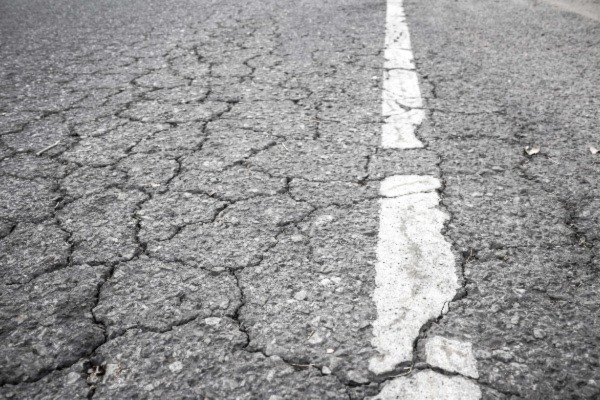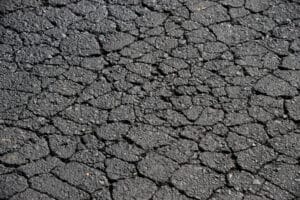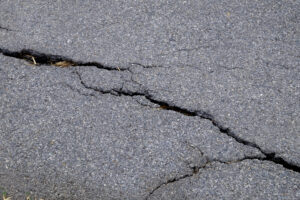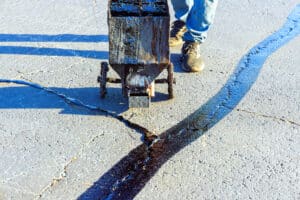Every home and property owner knows that their asphalt breaking will eventually occur overtime due to traffic and weather conditions. However, asphalt breaking happens for many reasons and there are various depths to the level of damage depending on how well maintained it is and your response time. The less maintained asphalt is and the longer it takes for you to repair it, the more extensive the damage can be — and more costly to fix or replace.
Below we’ll break down the common reasons why asphalt breaking happens, how to avoid it, and the best possible solutions.
What causes asphalt breaking?
Several factors contribute to asphalt breaking. Here are some of the most common causes.
Weather and Sudden Climate Changes
Extreme weather conditions or sudden temperature changes can significantly impact the lifespan of pavement surfaces. Below we’ll break down the following weather elements that can cause asphalt breaking.
Rain and Improper Drainage
Heavy rain can cause water to seep into the cracks of the asphalt surface, resulting in further deterioration. This is because water expands when it freezes, causing the cracks to widen. In areas with a lot of rainfall, proper drainage can help mitigate the damage caused by rain. If your property has a defective drainage system, the run-off from your elevated areas can damage the asphalt surface and sub-base.
The best way to protect your asphalt from rain deterioration is through routine sealcoating. For newly paved asphalt, you should sealcoat within the first year and then reseal at least every three years as existing asphalt requires.
Heat
Intense heat can also damage asphalt surfaces, causing them to dry out and become brittle. Over time, this can lead to cracks and potholes. Areas that experience high temperatures should be regularly inspected for signs of deterioration.
Snow and Ice
Snow can cause asphalt breaking, especially when plowed or shoveled. Snowplows and shovels can scrape and dig into the asphalt, causing cracked asphalt and potholes. Areas with heavy snowfall should be properly plowed to avoid damage to the surface. Freeze-thaw cycles in particularly cold areas also heavily damage asphalt surfaces.
Heavy Vehicles and High Traffic
The constant movement of vehicles and heavy traffic can also contribute to asphalt deterioration. Over time, this can cause the asphalt surface to weaken, leading to cracks and potholes. This is particularly high for areas with heavy commercial traffic since trucks and equipment weight can cause asphalt breaking.
Spills and Stains
Spills and stains, such as oil and tire tread marks can also deteriorate the asphalt — especially in parking lots. These substances can seep into the asphalt, causing it to break down over time. Here are some common spills and stains that can damage your asphalt surface.
Oil Stains
Oil stains are one of the most common culprits of asphalt breaking. The oil can seep into the asphalt and soften it, making it more susceptible to cracks and potholes. Areas with heavy vehicle traffic, such as parking lots and gas stations, should be regularly inspected for oil stains.
Tire Tread Marks
Tire tread marks can also damage the asphalt surface over time, particularly in high-traffic areas. The constant pressure and friction from the tires can cause the asphalt to break down. Regular sweeping and seasonal cleaning can help mitigate the damage caused by tire tread marks.
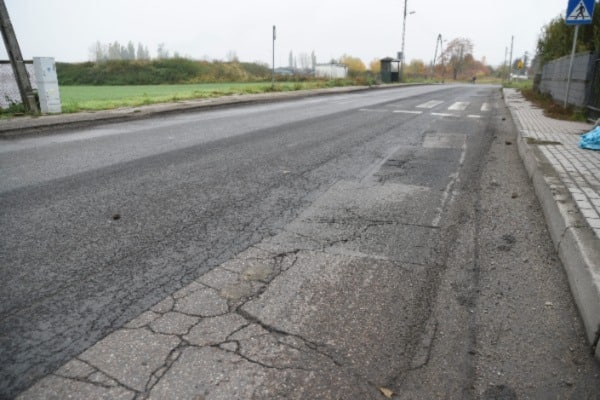
How to Protect Your Asphalt Surface from Breaking
To protect your asphalt surface and prevent it from breaking, here are some essential measures to take.
Crack Sealing
If you notice signs of asphalt breaking, such as cracks, it’s essential to repair them immediately. Prolonging these issues can lead to more extensive and costly repairs down the line.
Crack sealing involves sealing surface cracks, which can look cosmetically unpleasing. It’s particularly important in areas with a lot of rainfall, where water can easily seep into the asphalt cracks and cause further damage.
Sealcoating
Sealcoating is one of the most effective ways to preserve your asphalt surface from deterioration. This process involves applying a sealant to the asphalt’s surface, which helps prevent water and other substances from seeping into the surface. Sealcoating also helps to protect the surface from the damaging effects of UV rays.
Pothole Repairs
Pothole repairs are important measures to take to protect your asphalt’s surface. This process involves filling small potholes with a special sealant, which helps prevent water and other substances from seeping into the surface. Pothole repairs are the best pavement maintenance practice as they can damage vehicles and present safety hazards if left unchecked.
Asphalt Breaking? Contact Superior Asphalt for Your Home or Property
Asphalt, like many other surfaces, will eventually break down and show signs of wear and tear. By understanding the causes of asphalt breaking, you can take steps to prevent these issues from happening in the first place and take quick action at the first signs of damage.
At Superior Asphalt, we offer the following asphalt maintenance and repair services:
- crack sealing services
- asphalt repair and patching services
- sealcoating services
- parking lot striping services
Contact us today to discuss your specific needs and get started on restoring your asphalt surfaces to their original condition.
Related Articles:
WHAT IS RECYCLED ASPHALT? 3 BENEFITS FOR HOME AND PROPERTY OWNERS

